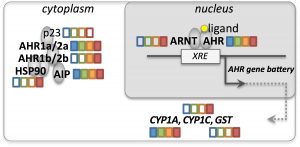Mechanisms of PCB resistance in Fish
In this research project, we are studying the effects of long-term, multigenerational exposure to high levels of contaminants on natural populations of animals inhabiting Superfund (hazardous waste) sites. We are using a fish model species, the Atlantic killifish Fundulus heteroclitus, populations of which have evolved resistance to polychlorinated biphenyls (PCBs) that act through the aryl hydrocarbon receptor (AHR). Killifish inhabiting New Bedford Harbor (NBH), MA, a PCB-contaminated Superfund site, exhibit heritable resistance to altered gene expression and toxicity of 2,3,7,8-tetrachlorodibenzo-p-dioxin (TCDD) and other AHR agonists as com pared to fish from a reference site, Scorton Creek, MA (SC). We have identified and cloned four distinct AHRs (AHR1a, AHR2a, AHR1b, and AHR2b), ARNT2, hypoxia-inducible factors (HIFs), and an AHR repressor (AHRR) in killifish. Killifish AHR genes are highly polymorphic and allele frequencies differ between populations of dioxin-sensitive (SC) and dioxin-resistant (NBH) fish. To elucidate the role these and other genes (AIP) in the sensitivity and resistance to PCBs, we are using CRISPR-Cas9 genome editing technology to produce loss-of-function mutants of these genes.
Representative papers:
The genomic landscape of rapid repeated evolutionary adaptation to toxic pollution in wild fish.
Reid NM, Proestou DA, Clark BW, Warren WC, Colbourne JK, Shaw JR, Karchner SI, Hahn ME, Nacci D, Oleksiak MF, Crawford DL, Whitehead A (2016)
Science 354: 1305-1308.
Targeted mutagenesis of aryl hydrocarbon receptor 2a and 2b genes in Atlantic killifish (Fundulus heteroclitus).
Aluru, N., Karchner, S.I., Franks, D.G., Nacci, D., Champlin, D., Hahn, M.E., 2015
Aquat.Toxicol. 158:192-201. PMCID: PMC4272816
Mechanistic Basis of Resistance to PCBs in Atlantic Tomcod from the Hudson River.
Wirgin, I., Roy, N. K., Loftus, M., Chambers, R. C., Franks, D. G., and Hahn, M. E.
Science 331, 1322-1325 (DOI: 1310.1126/science.1197296).

Funding Agencies
This research has been conducted as part of the Boston University Superfund Research Program and has been supported by the Superfund Research Program of the National Institute of Environmental Health Sciences.
Partners/Collaborators
The research has been performed in collaboration with researchers at the U.S. Environmental Protection Agency (EPA), University of California Davis, and others.